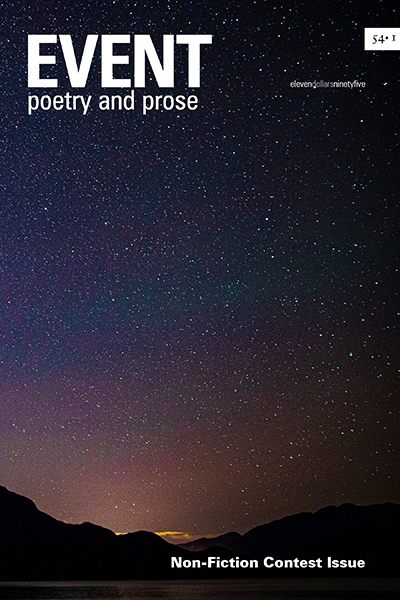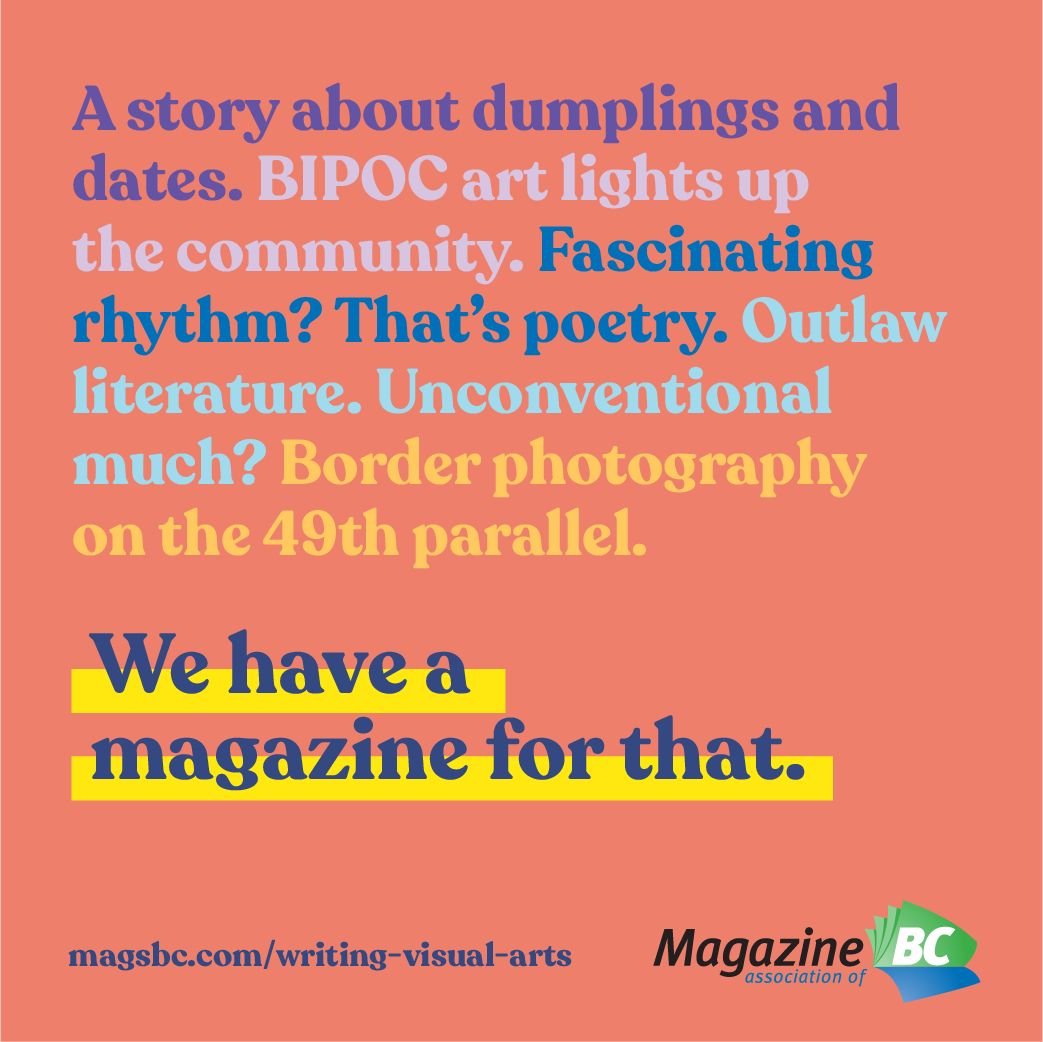Nick Thran Reviews New Poetry Collections from Oana Avasilichioaei and Moez Surani for EVENT 49/1

Nick Thran Reviews:
Oana Avasilichioaei, Eight Track, Talonbooks, 2019
Moez Surani, Are the Rivers in Your Poems Real, Book*hug, 2019
In his book-length essay The Animal That Therefore I Am, philosopher Jacques Derrida points to the abyss between double meanings of the question ‘Qui suis-je? (Who am I?)’ and ‘Qui suis-je? (Who or what am I following?).’ It’s within this abyss that Avasilichioaei’s assemblage of devices, Eight Track, could be said to operate: providing the reader with global contexts, raw surveillance data, dramatic voice pieces, discordant noise and photographic documentation—all in attempts to widen thinning spaces in our contemporary world between the watcher and the watched, or, as she says in the penultimate section’s dialogue with Derrida’s essay, ‘might the animal/trace and retrace a route to its own animalhood?’
‘Animutt,’ her principle of deviant poetics that results from this dialogue with Derrida and others, ‘traces/the autobiographical animal, ventures responses//celled in the autobio-/graphical animal.’ In efforts to make such a manifesto manifest, she employs eight approaches (and some linked online bonus noise), section-length takes headed by a variety of definitions and usages of the word ‘track.’
Echoing the dissociative, discomforting eyes and ears of mechanical monitoring or recording devices, Eight Track’s radical poetics reveal only the thinnest traces of an ‘I’ or an ‘author,’ the one who, in Derrida’s line of questioning, both ‘is’ and ‘is following.’ One may glean these traces from her curatorial decision-making, which in some sections foregrounds the visual: from the humour evident in the confrontational flip of photographing portraits of the surveillance cameras in her Montreal neighbourhood against their backdrops of tree, brick, graffiti and fascia; or in the evident awe implied by including plane’s-eye views of the Nasca Lines—the grand desert figures created by Indigenous peoples of Peru—as their own section.
Other, more language-based traces of the ‘I’ can be sourced in poems such as ‘The Surveyor,’ where Avasilichioaei appears to connect the work of the poet with the surveyor’s work, where: ‘You seemed to stand your ground even when/the ground was soft and questionable.’ The most striking trace of authorship appears in the book’s longest section, ‘Tracking Animal,’ wherein Avasilichioaei, ‘appeal[ing] to the/ institutions of mouthing animal,’ brings numerous skills as a translator, editor, philosopher and poet to bear upon the reality, vivacity and possible mutations to be found rattling within the cage of a single word: ‘animal.’ Every unit of utterance in this section includes some form of the word, a rigorous constraint that Avasilichioaei picks apart through close reading, philosophical argument and an expert’s understanding of the slippery borders between words in different languages. The result, simultaneously claustrophobic and joyous, is identifiably her own.
In areas where the work explores more sinister aspects of surveillance culture as applied to the global refugee crisis and remote warfare, the I, and perhaps animutt, is less present; put another way, ‘The subject is the vigil, not the deviation.’ ‘On Origins,’ for example, presents a fictionalized radio play, situated as a recording of a conversation between an immigration officer, an asylum seeker and their translator. In adherence to the imaginary room under surveillance, the piece isolates the explosive gaps that exist between: 1) the agenda and assumptions of the questioner; 2) the seemingly slight (but freighted) deviations of the translator; 3) the seeker trying to narrate their journey in the context of yet-to-be-processed fear; and 4) the choreography of material sounds that cannot be sourced to a human voice (the scraping of chair legs, the slurping of liquids, etc.). Running above and below this text are ticker tapes of possible would-haves and could-haves after the fact: in other words, conversations an asylum seeker may have with family members or lawyers about what they should have said or done but could not have done under such duress. It’s an effective web of forms, able to capture multiple tensions.
Another section, ‘Drone Operators,’ includes a partially redacted transcript of a remote drone attack on an unnamed area that includes the presence of women and children. While ‘[r]equest permission to sparkle if they can’t get eyes on the coords’ guts with unintended lyricism, this particular section exists in a more nebulous area between public record and claim to authorship. The sense of justice inherent in including the record as is is sometimes at odds with the animating features of the record as poem. Sections of Eight Track such as ‘Drone Operators’ suggest that our capacity and willingness to adhere to the record can be both problematic and necessary to a poetry that does not obfuscate. Avasilichioaei’s poetics are so fully immersed in their strategies that the watchful reader is likely to remain both alert and willing to consider her points.
Derrida again: ‘[T]he autobiographical animal would be the sort of man or woman who, as a matter of character, chooses to indulge in or can’t resist indulging in autobiographical confidences. He or she who works in autobiography.’ This passage provides a convenient description of some animating features of Moez Surani’s fourth collection, Are the Rivers in Your Poems Real. This is a book of lyric and conceptual inventories and travelogues. The speakers of his lyrics are often situated upon or in proxy to the very real rivers of the world: the Ganges, with its dual status of being the most sacred but also one of the most polluted rivers; the Neva in Russia, with its ‘relatable’ canals; the Nile with its—quite literal—international reach. Accompanying these are the conceptual rivers, built from found text or strict data taking. These conceptual rivers include ‘The Back Burner,’ a tower of unused New Yorker headlines, and ‘Every Day I Was in Love (Even Though I Didn’t Say So),’ a six-page column of dates running from April 20, 2014 to September 22, 2014.
Of these two approaches, the first highlights various desires: to be known, to be seen, to be understood and to be loved. The second, the conceptual approach, features stricter, more rational and visual concepts of world citizenship, highlighting the various vectors of power, which have the capacity to dwarf the individual and their desires. The two approaches appear as separate autobiographical banks between which a swift, palpable and, most significantly to this text, equitable poetics might flow. The long poem ‘It Is Saturday and I Have So Much to Do’ makes clear the challenge of maintaining the health of such rivers:
I have been unreasonable. I have wanted
to know all people, all tastes, to mix myself with all arts and eras,
know all cities by instinct.
This desire harasses my reasonability.
I am 39 and still feel how I felt when I was 20.
In sum, I can never weaken or die.
It’s a contradictory mix of confession and stubbornness, starting and stopping, written in lines meant to mimic the river’s flow. Such a poem actively resists summary, even as its rhythms require the occasional declarative statement to mediate tributaries of thought (‘riding the miscellany,’ as the title poem calls it).
‘It Is Saturday…’ and several other poems bring to mind one of Fernando Pessoa’s famous heteronyms, the ‘jaded sensationalist’ Alvaro de Campos. de Campos shares with Surani’s speaker a similar ecstatic desire to contain all things within himself, a desire tempered with existential longing. Here is a passage from Richard Zenith’s translation of Pessoa’s ‘Time’s Passage’:
All eras have belonged to me for a moment,
All souls for a moment have had their place in me.
Current of intuitions, river of imagining me as them,
Always wave after wave,
Always the sea—now growing strange,
Always drawing away from me, indefinitely.
‘It Is Saturday and I Have So Much to Do’ closes with the unexpected declaration, ‘I will go to India,’ where the echo of Pessoa’s heteronyms meets associations with the 10 avatars of the Hindu god Vishnu. It’s the right kind of escape for a poem so concerned with many-ness and flow, a poem equipped with many full heads and full hands.
The more rational or conceptual experiments in the collection can come across as parched: ‘Happiness’ is a list of phone numbers, and ‘Best Decisions of My Life So Far’ effaces all autobiographical content for a simple collection of yeses or nos. In ‘New York/Week’ words are pictograms situating a plate of dumplings, an itinerary and a trip to see some Chinese art (heavily featuring the goose) on the page. My issue is not with the pictogram as art, or with presenting the phone number as a gateway to the connective tissue between voices; it’s that the distance between the conception and the execution of these particular pieces doesn’t appear to widen within their bodies of text. They read as fully formed, unwilling to include the reader as an active participant. There may be a broader metaphoric concept to be gleaned from this approach—conceptual inlets or stones placed within the lyric rivers of the collection’s other poems. ‘Poems to Be Performed By Kevin McPherson Eckhoff, With or Without A Green Elfin Mask’ is, among the more experimental pieces, a more promising outlier: full of inventive scenarios for performance poems. It’s also full of evident and joyous affinity for the performer and the potential performances, and for the potential of scenarios to animate the blurry lines between construct and confession, lyric and concept, reason and desire—real rivers, for sure.
—Nick Thran













